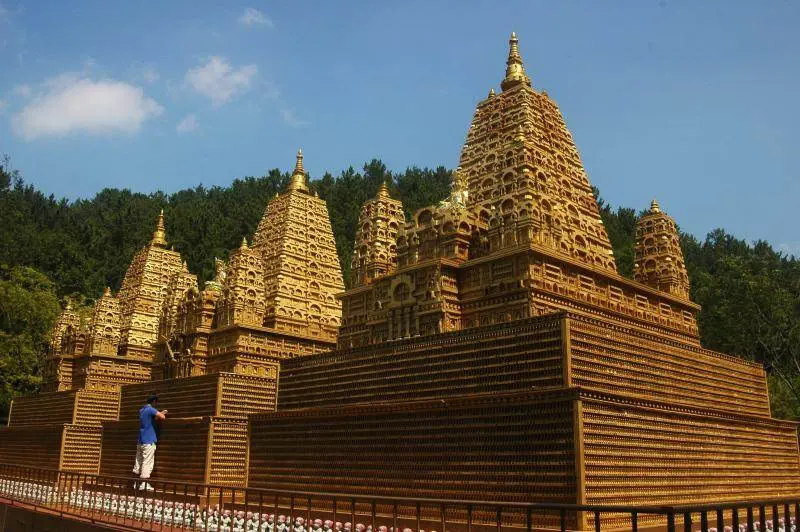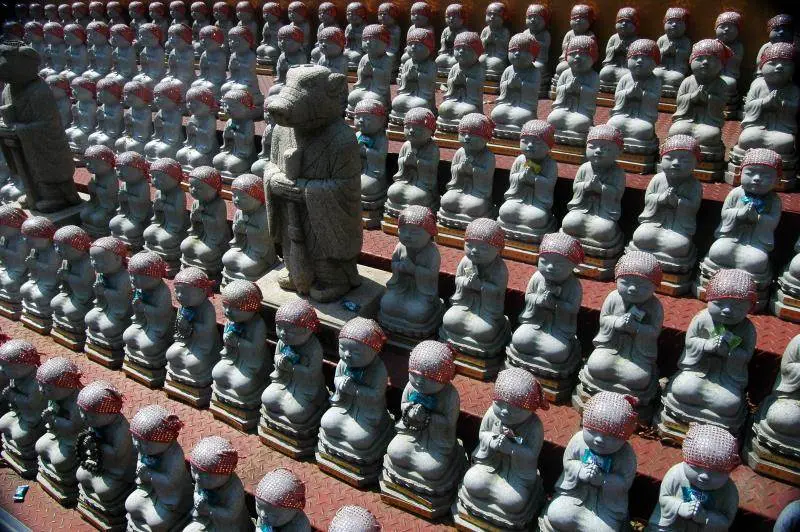
Author’s note: A hat tip to Sherwin at gyeongjublog.com for writing about this temple first.
Most Buddhist temples are quiet. Reverent-feeling. Relaxing. Here at Manbulsa, (literally: the temple of 10,000 Buddhas), you get two out of the three. Upon arriving, you’ll immediately begin to sense something is different about this particular temple. The planning for this particular temple dates back to 1981, which compared to most Buddhist temples is a mere gleam in the Buddha’s eye. The bottom part of the tower holds tiny Buddhist statues – each perhaps 5 centimeters (2 inches) tall apiece, each one paid for by a donor.

You see these at the bottom of the three towers – the temple’s website calls them 유자영가, or yujayeongga. Apparently, these are child monk statues made of stone dedicated to children that were aborted, paid for by the parents that killed them. By confessing your sin and guiding your child to an “gentle and easy death”, you can still be saved. See this official page if you don’t believe me.

A number of prayer wheels – with Chinese lettering. This opening area seemed in the middle of some construction work, and this wooden framing certainly didn’t seem like a permanent thing.

Here is where the reverence begins to wear off. The first couple of dozen Buddha statues begin to look strangely identical – then you realize they are. That they’re made in plastic only seems to decrease the ‘reverence’ factor while increasing the ‘kitsch’ factor.

The half-open eyes were seen in virtually every sizable Buddhist statue.

Don’t ask me why, but insects are fun to photograph.

Another source of income for the temple – burial plots. Seven different areas hold the remains of the devoted, and each tomb costs 2,000,000 to 6,000,000 won. What’s a few thousand dollars when your body rests in peace next to a Buddha statue?

Just in case you feel the need to leave an additional donation, the 불전함 (donation) box awaits.

A lying Buddha – not precisely an original work of art, but still a nice additional to what would otherwise be a graveyard. The ‘tunic’ seemed more like a cloth held down by lotus flowers, however.
If you’re in a car, driving from one part of this oval-shaped areas to another is a matter of minutes. If you’re walking, a dirt trail guides you from one Buddha to another – it’s a 15 minute walk in the shade. Bring the bug spray, though – they annoyed the crap out of us.

The famous 33-meter-tall Amitabha Buddha statue – visible from the Gyeongbu Expressway and atop a number of smaller Buddha statues. Upon closer inspection, a number of golden-colored flecks were found all around the statue. Though it’s not obvious from this picture, some damage to the statue made me wonder what sort of maintenance had been done here.
A bit more walking past another cemetary, we came full circle back to the entrance:

One final plastic Buddha otherwise resting on the water.
Directions to Manbulsa: Take a train to Yeongcheon station (from Seoul, more trains get there via transfer through Dongdaegu station than direct). From Yeongcheon train station, take a taxi to Manbulsa (about 13,000 won one-way), or walk the 700 meters to the bus terminal and catch a local non-numbered bus to Manbulsa. They leave Yeongcheon Bus Terminal at 7:30am, 1:30pm, 4:30pm, and 6pm; 1,500 won admission, 20-30 minute ride. From Manbulsa back to Yeongcheon Bus Terminal, expect the buses at 8:25am, 2:25pm, 5:25pm and 6:45pm. For more information, go to http://www.manbulsa.org.



Wow… this is great. I lived in freaking Andong for a year and never heard of this. Great post.
Well, thanks for this post. Add this to my "to-see" list. The area seems to have multicultural influences. Part of it feels so Malaysian/Hindu while other parts feel like something I'd see in Thailand. Great find!